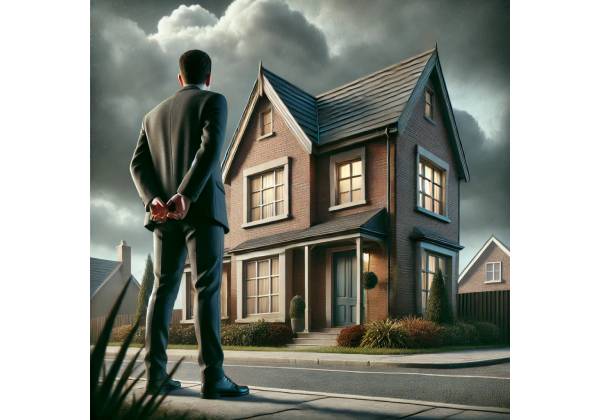What is domatophobia?
Domatophobia, also known as oikophobia, is a specific phobia defined by an intense and irrational fear of houses or being inside buildings. People with this condition may experience overwhelming anxiety when they are indoors or near their homes, making daily tasks and social interactions significantly more difficult. This phobia can range from discomfort in certain types of buildings to an inability to enter homes or enclosed spaces entirely.
Domatophobia can disrupt personal relationships, limit career opportunities, and cause social isolation. Avoiding homes or indoor environments can limit an individual’s ability to function normally in society, making the condition not only emotionally exhausting but also physically debilitating. Unlike claustrophobia, which is the fear of enclosed spaces, domatophobia is more specific to homes and buildings, making the nature of the fear more complex and linked to the symbolism or psychological associations with these environments.
Understanding domatophobia is critical for both those suffering from it and their support systems. With the proper approach, this phobia can be effectively managed, allowing people to regain control of their lives. In this guide, we will look at the symptoms, causes, diagnosis, and treatment options for domatophobia, providing a comprehensive resource for anyone affected by the condition.
Symptoms of Domatophobia
The symptoms of domatophobia vary greatly depending on the severity of the condition, but they are typically present in the physical, emotional, and behavioral domains. Recognizing these symptoms is essential for understanding how domatophobia affects daily life and how it can be treated.
Physical Symptoms
When people with domatophobia encounter homes or indoor environments, their bodies’ fight-or-flight response is activated, causing a variety of physical symptoms. These may include:
- Increased Heart Rate: The sight or proximity to a house may result in a significant increase in heart rate as the body reacts to the perceived threat.
- Shortness of Breath: Difficulty breathing or sensations of suffocation are common, particularly when forced to stay indoors or enter a building.
- Sweating and Trembling: Nervousness frequently causes excessive sweating, shaking, or trembling, especially when attempting to enter a home or remaining inside for an extended period of time.
- Nausea or Gastrointestinal Distress: Domatophobia-related anxiety can result in nausea, upset stomach, or other digestive problems.
- Dizziness or Fainting: In severe cases, individuals may become dizzy or faint as a result of elevated anxiety levels.
- Chest Pain or Tightness: As panic sets in, people may experience tightness in their chest, leading them to believe they are having a heart attack and exacerbating their fear.
These physical symptoms can be severe enough to prevent people from participating in routine activities like visiting friends’ houses, attending indoor events, or even living in their own homes without discomfort.
Emotional Symptoms
Domatophobia also has a significant emotional impact, as fear of houses or buildings causes feelings of dread, helplessness, and embarrassment. Emotional symptoms may include:
- Intense Fear or Panic: The mere thought of entering a home can instill an overwhelming sense of dread or terror, leading to full-fledged panic attacks in severe cases.
- Anticipatory Anxiety: People may become anxious long before they are confronted with a situation involving a house or building. This anticipatory anxiety can take over their thoughts for days or weeks, making it difficult to focus on anything else.
- Feelings of Shame or Embarrassment: Many people with domatophobia are ashamed or embarrassed about their fear, especially if it interferes with their social or professional obligations.
- Hopelessness: The inability to escape or avoid homes can cause feelings of hopelessness or depression, especially if the phobia severely restricts the individual’s lifestyle or relationships.
- Irritability: People who experience persistent fear and avoidance behaviors may become irritable or frustrated, especially if their fear interferes with their daily activities.
These emotional responses can have an impact on relationships, job performance, and overall quality of life. They may also contribute to the development of other mental health conditions, such as depression or generalized anxiety disorder.
Behavioral Symptoms
Domatophobia frequently causes significant lifestyle changes as people use avoidance strategies to cope with their fear. Typical behavioral symptoms include:
- Avoidance of Houses and Buildings: The most common behavioral symptom is the refusal to enter homes, apartments, or other buildings. Individuals may refuse to attend social events, go to work, or even stay at home.
- Compulsive Behaviors: Some people may develop compulsive behaviors in response to their fear, such as repeatedly checking to ensure they will not have to enter a house or building.
- Reluctance to Travel or Relocate: The fear of encountering homes or buildings in unfamiliar settings may deter people from traveling or relocating to new places, particularly in urban areas where buildings are common.
- Social Isolation: Domatophobia can cause social withdrawal as people avoid situations that require them to enter someone’s home or a public building, reducing their social circle and opportunities for connection.
- Dependence on Others: People with domatophobia may rely on family, friends, or caregivers to assist them with daily tasks that require entering or remaining inside buildings.
These behavioral symptoms frequently cause significant disruptions in the individual’s personal and professional lives, leading to isolation and a general decrease in well-being.
Causes and Risk Factors for Domatophobia
Domatophobia’s exact cause is unknown, but it is thought to be a combination of psychological, environmental, and genetic factors. Several common causes and risk factors have been identified as potential contributors to the development of this phobia.
Psychological Causes
- Traumatic Experiences: One of the most common causes of domatophobia is a traumatic event that occurred in a home or building. This could include an accident, a fire, a break-in, or any other traumatic event that occurred in a home or enclosed space. The fear becomes linked to homes, causing anxiety whenever the person is near or inside a house.
- Conditioning: Domatophobia can also result from classical conditioning, in which the individual associates houses or indoor environments with negative emotions or fear. For example, if someone had a panic attack inside a home, they may develop a fear of entering homes in general.
- Comorbid Conditions: People with other anxiety disorders, such as claustrophobia (fear of enclosed spaces) or agoraphobia (fear of being in situations where escape is difficult), may be more likely to develop domatophobia. Anxiety caused by being in certain environments may specifically affect homes and buildings.
Environmental Factors
- Negative Associations with Homes: In some cases, domatophobia can develop as a result of negative experiences or associations with the concept of “home.” People who have experienced abuse, neglect, or severe stress in their home environment may associate houses with danger or discomfort.
- Cultural or Social Influences: Certain cultures or communities may have specific beliefs or stigmas associated with houses or buildings, which contribute to the development of domatophobia. Superstitions about haunted houses or homes that are associated with bad luck, for example, may exacerbate the fear.
Biological and Genetic Factors
- Genetic Predisposition: Some studies suggest that people who have a family history of anxiety disorders or specific phobias are more likely to develop them themselves. This genetic predisposition may make some people more likely to develop domatophobia following a triggering event.
- Brain Chemistry: Imbalances in brain chemicals such as serotonin or dopamine can lead to anxiety disorders, including specific phobias. These neurochemical imbalances may influence how the brain processes fear and stress, raising the possibility of developing a phobia.
Understanding the causes and risk factors of domatophobia can assist individuals and healthcare providers in better managing the condition and developing more individualized treatment plans.
How Domatophobia is Diagnosed
Domatophobia is diagnosed after a thorough evaluation by a mental health professional. A thorough psychological evaluation, a patient history, and an investigation into the specific triggers and symptoms that characterize the individual’s fear of homes or buildings are all part of the diagnosis process.
Clinical Evaluation
The first step in diagnosing domatophobia is a clinical evaluation, in which a therapist or psychiatrist will learn about the patient’s anxiety history, any previous traumatic experiences, and the nature of their fear. This may include talking about when the fear first appeared, how it has progressed, and how it affects their daily lives.
Symptom Assessment
A mental health professional will evaluate the individual’s physical, emotional, and behavioral symptoms when confronted with homes or buildings. The clinician may use structured interviews, self-report questionnaires, or diagnostic scales to assess the severity of the phobia.
Diagnostic Criteria
To confirm a diagnosis of domatophobia, the clinician will compare the patient’s symptoms to those outlined in the Diagnostic and Statistical Manual of Mental Disorders (DSM-5). According to the DSM-5, the individual’s fear must be ongoing, excessive, and cause significant distress or impairment in social, occupational, or other important areas of functioning. The fear must also be limited to homes or buildings and not related to another anxiety disorder, such as claustrophobia or agoraphobia.
An accurate diagnosis is required for developing an effective treatment plan and ensuring that domatophobia is not confused with another anxiety-related condition.
Treatment Alternatives for Domatophobia
To successfully manage domatophobia, a multifaceted approach is required, which includes therapy, medication, and lifestyle changes. The goal of treatment is to help people overcome their fear of homes and buildings, improve their coping mechanisms, and reclaim control of their lives.
Cognitive Behavioral Therapy (CBT) is a highly effective treatment for domatophobia. CBT assists individuals in identifying and challenging the irrational thoughts and beliefs that cause their fear of houses or buildings. Patients who learn to reframe these thoughts can reduce their anxiety and develop healthier responses to their phobias.
- Cognitive Restructuring: In CBT, clients work with a therapist to examine and reframe their distorted beliefs about their homes or indoor environments. For example, a person suffering from domatophobia may believe that if they enter a house, something terrible will happen to them. The therapist assists the individual in questioning this belief and replacing it with a more balanced perspective, such as acknowledging that houses are generally safe places.
- Exposure Therapy: A key component of CBT, exposure therapy entails gradually exposing the individual to the object of their fear—in this case, homes or buildings—in a safe and supportive environment. Exposure usually begins with less threatening situations, such as looking at pictures of houses or talking about being indoors, and progresses to real-life exposure, such as entering a home for brief periods. This systematic desensitization gradually reduces the fear response, making the individual more comfortable in these environments.
- Developing Coping Mechanisms: CBT also focuses on giving people practical tools for dealing with anxiety. Techniques such as deep breathing, mindfulness, and progressive muscle relaxation can help people stay calm when their anxiety levels rise. To better manage fear, these strategies can be used both during and outside of therapy sessions.
Acceptance & Commitment Therapy (ACT)
Acceptance and Commitment Therapy (ACT) is an additional effective treatment for domatophobia. Rather than focusing on anxiety reduction, ACT teaches people to accept their fears and make decisions based on their personal values rather than avoidance.
- Acceptance: ACT teaches people to accept the discomfort associated with their phobia rather than avoiding it. For example, instead of attempting to suppress their fear of houses, people are encouraged to acknowledge it while still engaging in meaningful activities such as visiting friends or attending indoor social events.
- Values-Driven Behavior: ACT encourages people to focus on what is important to them and make decisions based on their values, not their fears. This may entail learning to tolerate the discomfort of being in a house in order to spend time with loved ones or achieve personal goals, such as being able to live independently.
- Mindfulness: ACT uses mindfulness techniques to help people stay present and grounded when anxiety strikes. Individuals who observe their thoughts and feelings without judgment can reduce the intensity of their fear and stay focused on the present moment.
Medication
In some cases, medication may be prescribed to alleviate the anxiety symptoms caused by domatophobia. Medications are usually used in conjunction with therapy because they do not treat the underlying causes of the phobia but can help reduce anxiety levels, making therapy more effective.
- Selective Serotonin Reuptake Inhibitors (SSRIs): SSRIs are a type of antidepressant that is commonly prescribed to people suffering from anxiety disorders, such as specific phobias. These medications work by increasing serotonin levels in the brain, thereby regulating mood and reducing anxiety.
- Benzodiazepines: Benzodiazepines are fast-acting anti-anxiety medications that can be prescribed for short-term use, especially in situations requiring immediate relief, such as before exposure therapy sessions or when confronted with particularly difficult situations. However, because of the risk of dependence, these medications are usually used with caution and for short periods of time.
Virtual reality exposure therapy (VRET)
Virtual Reality Exposure Therapy (VRET) is a novel treatment method for domatophobia. VRET employs virtual reality technology to immerse people in simulated environments in which they can confront their fears of houses or buildings in a controlled and safe setting. This type of exposure therapy enables people to practice coping with their fears without having to enter a real building, which can be especially beneficial in the early stages of treatment.
- Immersive Experience: VRET enables patients to gradually confront their fears in a virtual setting, beginning with less threatening simulations and progressing to more realistic scenarios. This helps the individual become desensitized to the fear, making it easier to apply those skills in real-life situations.
- Safe Environment: Because VRET takes place in a controlled environment, individuals can practice confronting their fears without the unpredictable nature of real-world situations. This controlled exposure can help people gain confidence before they face exposure in the real world.
Hypnotherapy
Hypnotherapy is another therapeutic approach that may help people with domatophobia. During hypnotherapy, a trained therapist leads the client into a deeply relaxed, trance-like state in which they can investigate the underlying causes of their fear and form new associations with homes or buildings.
- Relaxation and Suggestion: Hypnotherapy helps people relax deeply, making them more open to positive suggestions about their ability to cope with fear. The therapist may assist the individual in reframing their thoughts about houses, thereby reducing the emotional intensity of their fear.
- Exploring Root Causes: In some cases, hypnotherapy can assist individuals in identifying past experiences or traumas that may have contributed to the development of domatophobia. By addressing the underlying causes, the individual can begin to heal and overcome their fears.
Self-Help Strategies and Lifestyle Changes
In addition to professional treatment, people suffering from domatophobia can use a variety of self-help strategies to better manage their condition. These strategies can be combined with therapy to improve treatment effectiveness and help people regain control of their lives.
- Gradual Exposure: Engaging in exposure on a daily basis can help people gain confidence and reduce anxiety. For example, taking small steps, such as standing near a house or briefly entering a building, can gradually desensitize the individual.
- Relaxation Techniques: Using relaxation techniques like deep breathing, yoga, or meditation can help reduce overall anxiety levels and make it easier to cope with the stress of being in homes or buildings.
- Support Networks: Creating a support network of friends, family, or support groups can be extremely beneficial for people who suffer from domatophobia. Having a trusted person talk to or accompany them during exposure exercises can provide emotional support and motivation.
- Setting Small Goals: Setting small, attainable goals for entering homes or staying indoors can help people gradually gain confidence. Celebrating every success, no matter how small, can boost motivation and reinforce progress.
Long-Term Outlook for People With Domatophobia
Most people with domatophobia can significantly improve their fear management with the right combination of therapy, medication, and self-help strategies. While complete eradication of the phobia is not always possible, treatment can help people reduce the severity of their anxiety and regain control of their lives.
Many people find that they can now engage in previously frightening activities such as visiting friends’ homes, attending indoor events, and even living comfortably in their own homes. The key to overcoming domatophobia is perseverance, support, and a willingness to confront the fear in a controlled and supportive environment.

















